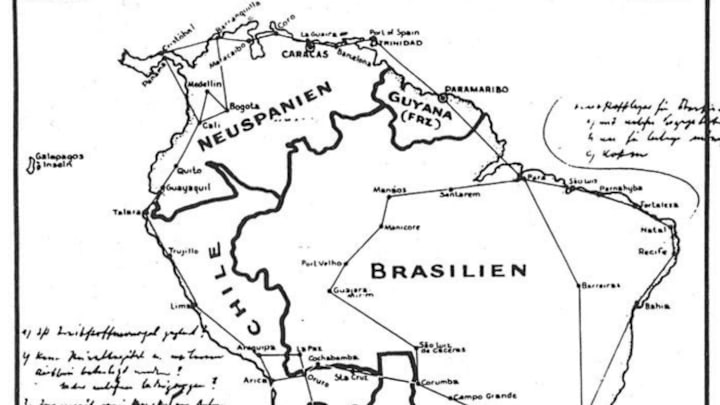In 1941, President Franklin D. Roosevelt faced an excruciatingly delicate task. Although he had promised—and campaigned on—a policy of American neutrality in World War II the year before, Roosevelt ached to help the Allies stem the increasingly ravenous Nazi threat sweeping across Europe. The question was: How, exactly, could he about-face and sell the war to his people?
In October of that year, he masterfully managed the feat. In his nationally-broadcast Navy Day address, Roosevelt made an extraordinary claim. “I have in my possession a secret map made in Germany by Hitler’s government,” he said. “It is a map of South America and a part of Central America, as Hitler proposes to reorganize it … This map makes clear the Nazi design not only against South America but against the United States itself.”

The map—presented as clear evidence of the Nazis’ hostile aspirations in what was (under the century old Monroe doctrine) still considered “America’s backyard”—had its intended effect. Although the Germans vehemently denied the map’s existence, the American people largely rallied behind what could now be pitched as a preemptive war of self-defense. And two months later, when Nazi Germany formally declared war on the United States, Roosevelt’s October speech was specifically mentioned as proof of American provocation.
The Counterfeit Plot
Decades after the war, Roosevelt’s Nazi map was discovered in his private documents and released. But according to Nick Cull, a historian at the University of Southern California who has studied the map, it is not at all what it appears to be. As Cull told Mental Floss in 2015, the map is actually a carefully prepared counterfeit—curiously, one made by neither the Germans nor the Americans.
“In truth, the map was a fiction forged by the British intelligence service,” Cull explains. By 1941, as the Nazis reached the French coast, the British had all the reason in the world to try to push the Americans out of their neutral stance. “It was well known that maps are incredibly powerful and effective tools in propaganda—they can lend a threat a certain level of tangibility,” Cull said. “The British had not forgotten that their leak of the Zimmerman telegram, in which the Germans promised Mexico Texas if they invaded, had pushed America to embark into World War I.”
Indeed, historical documents show that the map was the brainchild of William Stephenson, a former Canadian air ace and personal friend of Winston Churchill, who by 1941 “was basically running British intelligence in North America, doing various operations to annoy the Germans to wear down American isolationism,” Cull said.
Stephenson—who had collected a rag-tag team of intelligence operatives, including a prominent ad-man, the philosopher Alfred Ayer, a British song-writer, one of the co-writers of the Wizard of Oz screenplay, and, at one point, Charlie and the Chocolate Factory’s own Roald Dahl—had the map loosely based on several actual Nazi-made South American maps, but “redrew the boundaries in a quite carefully selected way to maximally upset everybody,” Cull said.
According to a memoir of one of Stephenson’s eclectic team’s members, the original plan was to plant the map in Cuba somewhere that the FBI would come across it on their own. But it is believed that, instead, the British just handed the map over themselves, claiming it was discovered in a Nazi safe-house raid.
A Complicit President?
One of the biggest remaining mysteries of Roosevelt’s counterfeit Nazi map is whether or not the president himself was aware of the ruse. After all—real or fake—the secret, unseen map worked entirely in Roosevelt’s interest.

Cull believes Roosevelt may have known, or at least suspected, that the map was a fraud. “What convinced me,” he said, “was that if you look at Roosevelt’s own handwritten edits in the first few drafts of his Navy Day speech, you can see that he crosses out a line that says ‘I have in my possession a map of undoubted authenticity’ and eventually revises it to ‘I have in my possession a secret map.’ It’s almost like he’s trying to distance himself from the smoking gun in those revisions.”
Discover More Stories About History:
A version of this story ran in 2015; it has been updated for 2025.
